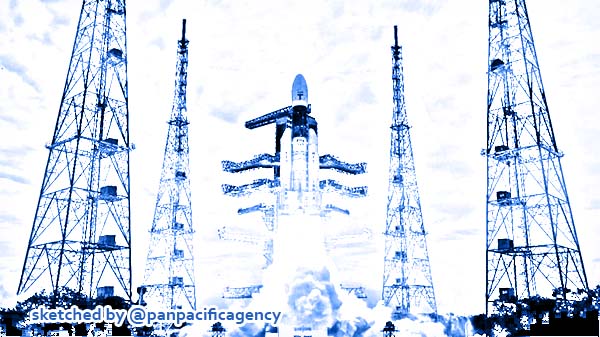India’s Chandrayaan-2 Moon lander Vikram separate from orbiter

Chandrayaan-2 took off from the Satish Dhawan Space Centre in Sriharikota on July 22 (Photo: Twitter/Isro). Sketched by the Pan Pacific Agency.
NEW DELHI, Sep 2, 2019, India Today. Pragyaan and Vikram are finally on their way to the Moon. After a journey of around a month and a half, Chandrayaan-2 is just six days away from achieving the unachieved — landing a rover on near the south pole of the Moon, a feat unaccomplished by any other country, reported the India Today.
Praygyaan is Chandrayaan-2 six-wheeled rover that is currently housed in the Vikram lander. The lander and the rover succesfully broke from the Chandhrayaan-2 orbiter Monday afternoon and began their own journey to the Moon.
The separation took place at 1:15 pm Monday afternoon, the Indian Space Research Organisation (Isro) said. Vikram is now in an orbit of 119 kms x 127 kms around the Moon — while on this orbit, the closest Vikram will come to the lunar surface will be 119 kilometres while the farthest it will be is 127 kilometres.
The orbiter is also flying in the same orbit and will continue to do so for the next one year.
Over the next few days, the Vikram lander will perform two manoeuvres to bring itself closer and closer to the Moon. By early September 4 morning, Vikram will get into an orbit that will see it fly over the Moon at a height of 36 kilometres at the orbit’s closest point and 110 kilometres at the farthest.
On September 7, the Vikram lander will begin a 15-minute powered descent, which for the Indian Space Research Organisation will be “15 minutes of terror”, to the lunar south pole. With the September 7 landing, India will become only the fourth country in the world to land a rover on the Moon and the only nation to do so near the lunar south pole.
WHY THE SOUTH POLE
The south polar region of the Moon has not received sunlight for billions of years and is among the coldest spots in the Solar System. This, Isro says, makes lunar south pole region ripe to contain tonnes of water and “an undisturbed record” of the Solar System’s origins.
One of the chief reasons Chandrayaan-2, which launched from the Satish Dhawan Space Centre in Sriharikota on July 22, is going to the Moon’s south pole is to find out how much water is located under the lunar surface.
Chandrayaan-2’s predecessor, Chandrayaan-1 (which crash-landed an impact probe on the lunar surface) made history in 2008 by confirming the presence of water on the Moon. Chandrayaan-2 will aim to further the findings.
THE CHANDRAYAAN-2 MISSION
Apart from studying the presence of water on the Moon, Chandrayaan-2 will also perform experiments that will hopefully shed light on the origins of the Solar System and by extension, life.
The six-wheeled rover Pragyaan will roam the surface of the Moon for around 14 Earth days, performing surface and sub-surface experiments.
The Chandrayaan-2 orbiter, on the other hand, has a much longer mission life of around a year. The orbiter will revolve around the Moon and study the lunar atmosphere.
THE ROAD AHEAD
Chandrayaan-2 is a precursor to the ambitious Gagayaan project. Under the Gaganyaan mission, the Indian Space Research Organisation will send three Indians to space.
An Indian — Rakesh Sharma — has been to space. However, Rakesh Sharma flew as a cosmonaut onboard a Russian Soyuz capsule.
Gaganyaan will see three Indians fly to space on an Indian spacecraft carried by an Indian rocket. In fact, the powerful Geosynchronous Satellite Launch Vehicle Mark-III ‘Bahubali’ rocket that took Chandrayaan-2 to space is the same rocket that will be used for the Gaganyaan mission.